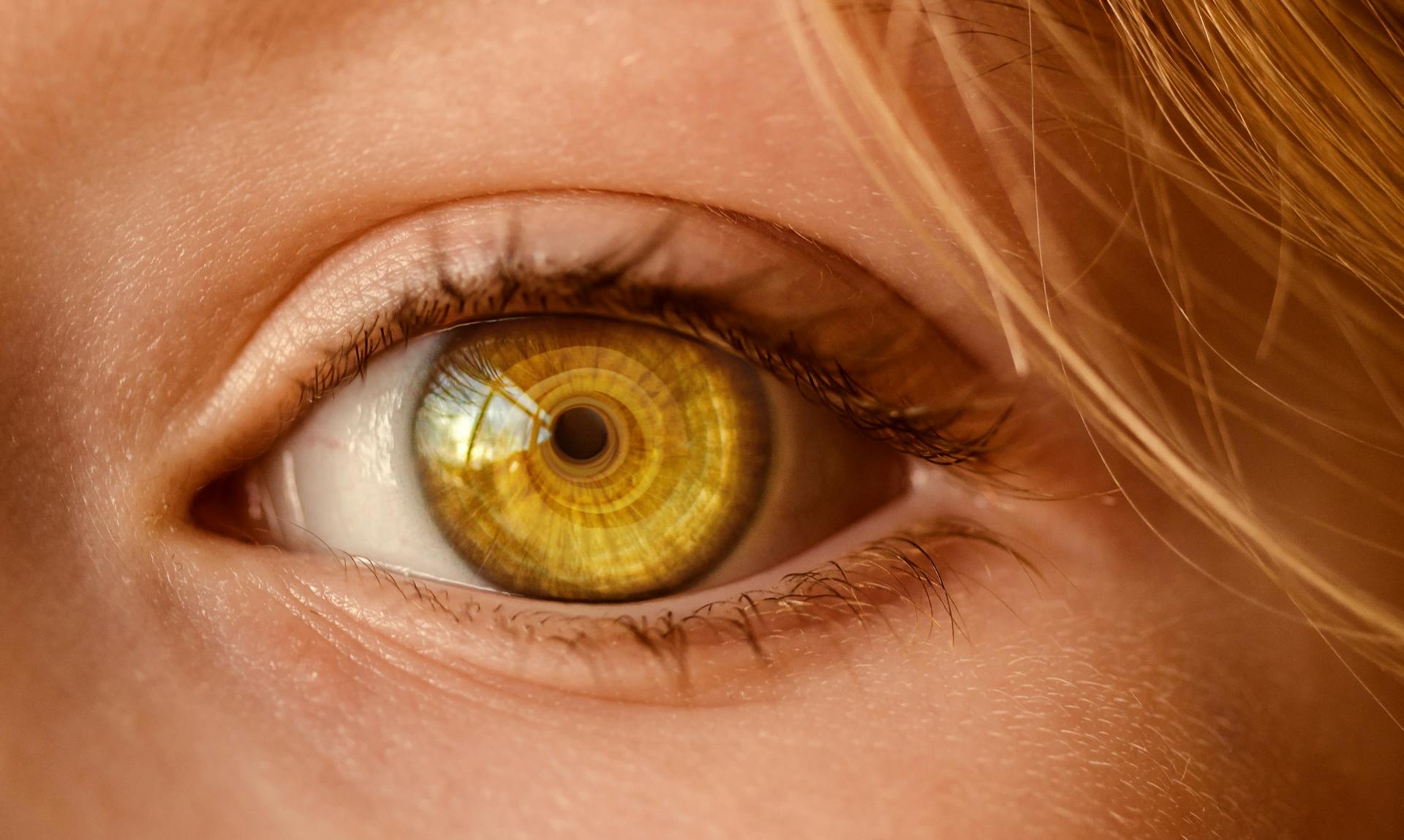
Eye allergies in dogs can be a real nuisance for our furry friends. Dogs can develop eye allergies due to exposure to environmental allergens, such as pollen, dust mites, or mold.
In some cases, eye allergies can be caused by food allergies or sensitivities. For example, if your dog is allergic to beef, it can trigger eye allergies.
Common symptoms of eye allergies in dogs include redness, itching, and discharge. These symptoms can be uncomfortable and even painful for your dog.
If you suspect your dog has eye allergies, it's essential to consult with a veterinarian to determine the best course of treatment.
What Are Eye Allergies in Dogs?
Eye allergies in dogs are caused by allergic reactions on the surface of the eyes. This can be triggered by various environmental factors.
Tree and grass pollen are common culprits behind eye allergy symptoms in dogs. Pollen can stimulate the immune system and trigger allergic reactions.
For more insights, see: Homemade Dog Treats for Allergic Dogs
Mold and mildew can cause eye problems and breathing difficulties in dogs. They can also lead to allergic reactions.
Dust and dust mites can cause sneezing and eye discharge in dogs. They can also trigger breathing difficulties.
Fleas can cause eye problems in dogs by triggering allergic reactions. Dogs often suffer from a specific type of flea allergy dermatitis (FAD) – a sensitivity to flea saliva.
Dander, hair, and feathers can be potential allergens for dogs. Pet and human dander and hair, as well as feathers, can cause allergic reactions.
Cigarette smoke can lead to itchy eyes in dogs and cause irritation to their cornea. This can then become an allergic reaction.
Colognes and perfumes can cause allergic reactions in dogs due to their intensely scented chemicals. These chemicals can irritate your dog's eyes and cause discomfort.
Here's a list of common allergens that can cause eye allergies in dogs:
- Tree and grass pollen
- Mold and mildew
- Dust and dust mites
- Fleas
- Dander, hair, and feathers
- Cigarette smoke
- Colognes and perfumes
Signs and Symptoms of
Redness of the eyes is a common symptom of eye allergies in dogs, and it's usually seen in both eyes. Squinting, pawing at the face, and discharge coming from one or both eyes are also common signs.
A dog with eye allergies may exhibit excessive tearing, which can be watery or mucousy. You might notice your dog squinting in light or pawing at their eyes or rubbing them along surfaces.
In addition to redness of the eye, other signs may include pawing at or rubbing the eye on the floor, squinting in light, keeping the eye closed, cloudy cornea, watery tearing eyes, and red discharge from the inner corner of the eye.
The following list highlights common signs and symptoms of eye allergies in dogs:
- Redness of the eyes
- Squinting
- Pawing at the face
- Discharge from the eyes
- Excessive tearing
- Squinting in light
- Pawing at or rubbing the eye on the floor
- Cloudy cornea
- Watery tearing eyes
- Red discharge from the inner corner of the eye
Diagnosis and Testing
Your veterinarian may perform several brief tests to rule out diseases with similar symptoms, like eye infections, dry eye, or corneal ulcers. These tests can help point your veterinarian to a diagnosis of eye allergies.
A test called "conjunctival cytology" may reveal inflammatory cells that confirm a diagnosis of allergic conjunctivitis, but the cells are not always present. If the cells are not present, your veterinarian will diagnose eye allergies through the process of elimination.
A full ophthalmologic exam will be conducted to evaluate the various structures of the eye, including the conjunctiva, cornea, tear ducts, retina, and eyelids. This exam is a crucial part of diagnosing eye allergies in dogs.
A Schirmer tear test examines your pet's tear production and helps rule out KCS or dry-eye syndrome. The test involves placing a small paper test strip in between the eyelid and the eye, which measures tear production.
If your dog is not responding to treatment, your veterinarian may refer you to a board-certified veterinary ophthalmologist or dermatologist for further evaluation. A veterinary dermatologist may recommend allergy testing to determine the exact allergen or allergens.
In rare cases, a biopsy of the conjunctival tissue around the eyes may be needed to achieve a definitive diagnosis. This biopsy is taken while your dog is under general anesthesia.
Here are some common tests used to diagnose eye allergies in dogs:
- Conjunctival cytology: a test that reveals inflammatory cells in the eye
- Schirmer tear test: a test that measures tear production
- Full ophthalmologic exam: a comprehensive exam of the eye structures
Treatment and Care
A recheck with your veterinarian after one to two weeks of treatment is recommended to assess how well the medications have worked.
If minimal improvement is seen, you may need to see a veterinary dermatologist for further testing and diagnosis.
In mild cases, flushing the eyes with sterile saline once or twice a day may be enough to remove the allergen and resolve the symptoms.
You should not use contact solution for this purpose.
Steroid-based eyedrops are often the treatment of choice for dogs with allergic conjunctivitis, but they can be very harmful to dogs with other, similar diseases in the eyes.
Severe cases may require the use of oral medications in addition to eyedrops.
There are several treatment options available for dog eye allergies, including saline flushes, eye washes, eye drops, and antihistamines.
Here are some popular treatment options:
It's very important to consult with your vet before treating your dog with any over-the-counter remedies.
Seasonal and Red Flags
If your dog is experiencing excessive pawing at or rubbing of the eye on the floor, it could be a sign of eye allergies. Squinting in light, keeping the eye closed, or watery tearing eyes are also common indicators.
Redness of the eye, cloudy cornea, or a red mass appearing from under the eyelid can be symptoms of various eye issues, including allergies, conjunctivitis, or keratoconjunctivitis sicca.
Some common causes of eye allergies in dogs include allergies to pollen, weeds, dust, or fiber, which can irritate the eye and cause symptoms. In addition to eye symptoms, seasonal allergies can also cause redness of the skin, crusts, moist skin, darkening of the skin, and thickening of the skin.
Here are some common signs of seasonal allergies in dogs that you should look out for:
- Excessive licking or chewing
- Saliva staining of the fur
- Redness of the skin
- Crusts or moist skin
- Darkening or thickening of the skin
- Odor to the skin or ears
- Head shaking
- Pawing at the ears, eyes, or face
Symptoms of Seasonal
As we dive into the world of seasonal allergies in dogs, it's essential to recognize the signs and symptoms that can indicate an issue. Excessive licking, usually of the paws, but the licking can be anywhere on the body, is a common sign of seasonal allergies.
A unique perspective: Winter Allergies Dogs

Saliva staining of the fur where the dog is licking the skin excessively is another telltale sign. Chewing/gnawing, scratching, and hair loss are also common symptoms that can be caused by seasonal allergies.
Redness of the skin, crusts, and moist skin are all signs that your dog may be suffering from seasonal allergies. Darkening of the skin (black pigmented skin) and thickening of the skin (elephant skin) can also occur.
Odor to the skin or ears, head shaking, and pawing at the ears, eyes, or face are all potential symptoms of seasonal allergies. Recurring scooting or licking of the anus due to anal sacs becoming problematic secondary to allergies is another red flag.
Here are some common areas of a dog's body that are affected by seasonal allergies:
- Paws (especially between the digits)
- Limbs
- Mouth
- Ears
- Abdomen
- Groin
- Armpits
- Tail
- Around the eyes
If you notice any of these symptoms, it's crucial to take action to prevent further discomfort and potential health issues for your dog.
Types of Seasonal

Seasonal allergies in dogs can be caused by a variety of allergens in the environment. The most common culprits include grass pollen, tree pollen, and weed pollen.
These allergens can be found in the air and can cause a dog's immune system to go into overdrive, leading to an allergic response. Grass pollen, in particular, is a common allergen that can cause symptoms in dogs.
Here are some of the most common types of seasonal allergens that can affect dogs:
- Grass pollen
- Tree pollen
- Weed pollen
- Molds and yeasts
- Dust mites and storage mites
- Fleas, causing flea bite dermatitis
It's worth noting that fleas can also cause flea bite dermatitis, which is a type of seasonal allergy in dogs.
Frequently Asked Questions
What do dogs' eyes look like when they have allergies?
Dogs with eye allergies often have red, watery, and itchy eyes, but a vet visit is needed for a definitive diagnosis
Does Benadryl help with dog eye allergies?
Yes, Benadryl can help relieve symptoms of dog eye allergies, such as watery eyes, but consult with your vet first to ensure safe use.
What home remedy can I use for my dogs eye irritation?
For dog eye irritation, try a cold, wet washcloth or a soft, cold compress to provide relief from inflammation and itching. This simple home remedy can be an effective first step in soothing your dog's irritated eye.
Sources
Featured Images: pexels.com


